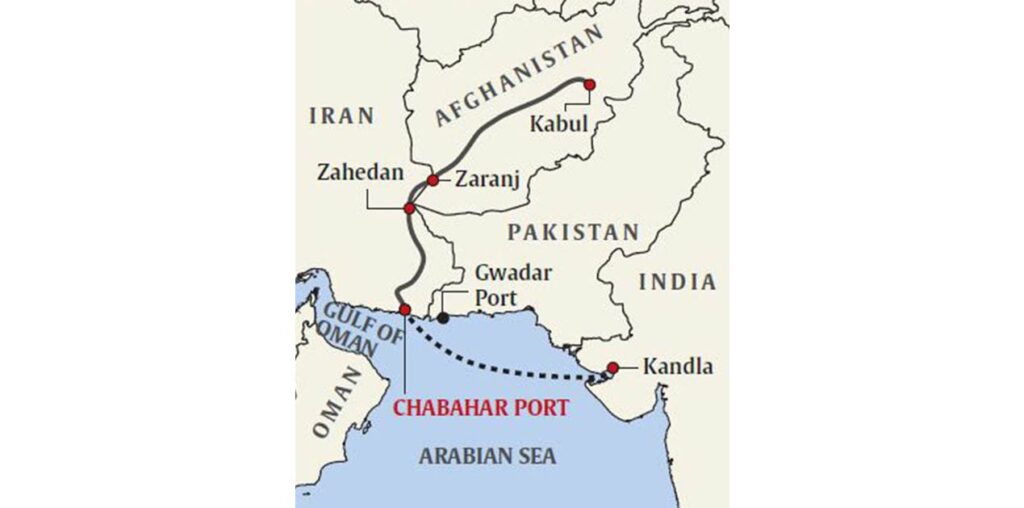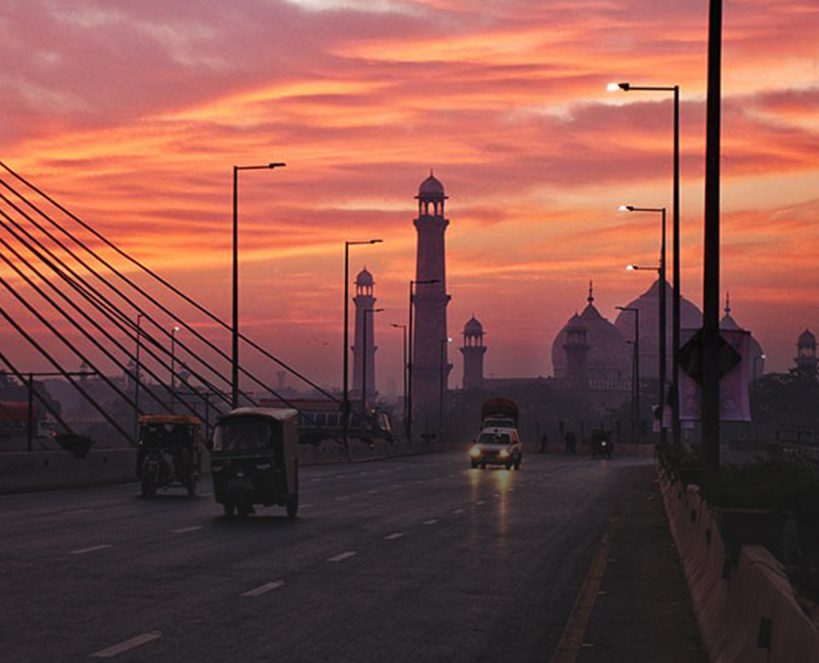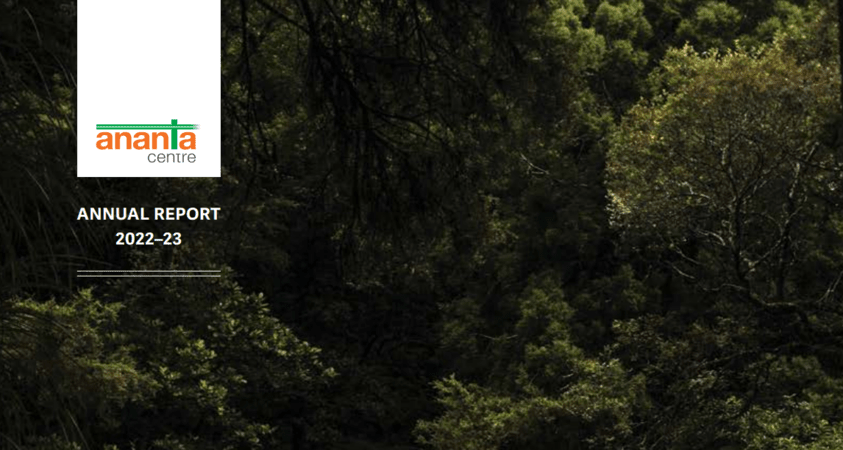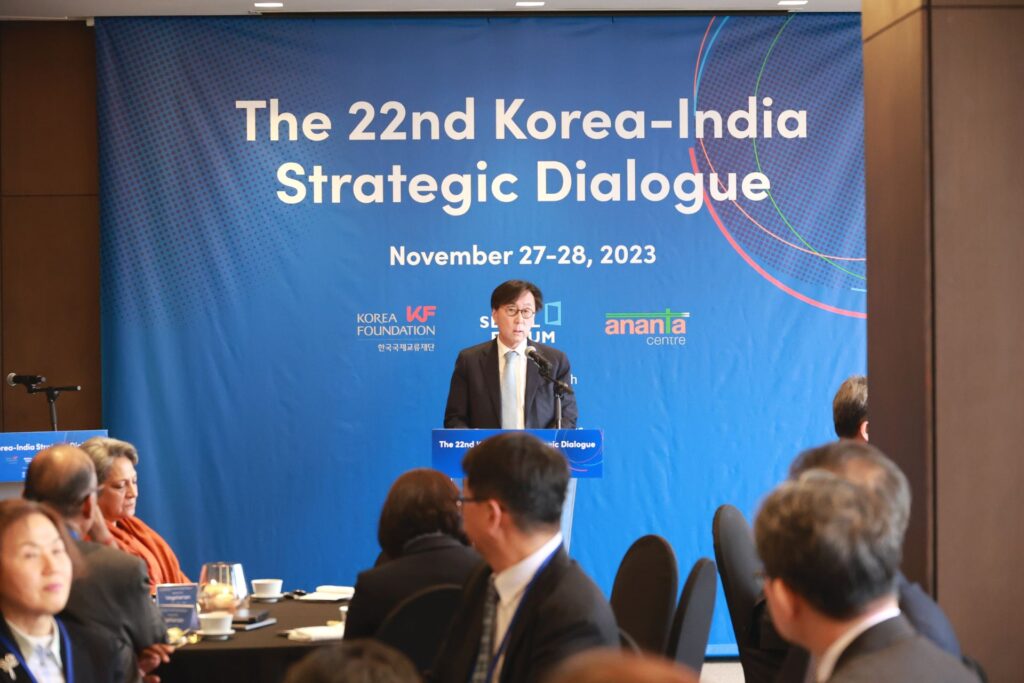Taliban in Town: India’s Diplomatic Tightrope
Introduction
Afghanistan’s Foreign Minister Amir Khan Muttaqi’s October 2025 visit to New Delhi is best read as a calibrated diplomatic step within India’s broader strategy toward Afghanistan. It underscores New Delhi’s intent to engage pragmatically with the Taliban regime to safeguard its strategic, security, and humanitarian interests, without extending formal recognition to the Taliban. The visit, including diplomatic meetings, discussions on trade and development, the reopening of India’s embassy in Kabul, and commitments around counterterrorism, signals a more assertive and pragmatic Indian approach toward Afghanistan under Taliban rule.

Image 1: India’s External Affairs Minister S Jaishankar and Afghanistan’s Foreign Minister Amir Khan Muttaqi (Photo: X/S Jaishankar)
This analysis aims to provide a comprehensive assessment of Amir Khan Muttaqi’s visit to India by situating India’s motivations and strategic goals, examining the new developments arising from the visit, and evaluating the associated risks, limitations, and trade-offs. It also seeks to outline plausible scenarios to guide India’s approach toward Afghanistan in the evolving regional and strategic context.
India’s Strategic Motivations
India’s calculus toward Afghanistan under the Taliban is shaped by a combination of security imperatives, regional ambitions, humanitarian considerations, and calibrated diplomacy. Foremost are security concerns, particularly threats emanating from remnants of militant groups such as Islamic State-Khorasan (IS-K) and Tehreek-e-Taliban (TTP) that could exploit Afghan territory as a base or transit route for attacks against other nations. New Delhi has consistently asserted that Afghan soil must not be used for hostile activities against any country.
Equally central to India’s strategy is the goal of enhancing connectivity and regional stability. Afghanistan’s geographic position makes it pivotal for linking with Central Asia, diversifying trade routes, and strengthening commerce via Iran’s Chabahar port—particularly since Pakistan is reluctant to facilitate India’s humanitarian assistance to Kabul. With significant investments in infrastructure and capacity-building over the years, India seeks to preserve and expand these gains. Afghanistan has urged India to push for lifting the Chabahar Port sanctions.

Image 2: The Chabahar Port is located in Iran, and India holds operational control. India Ports Global Limited (IPGL), a wholly owned subsidiary of the Indian government, took over operations in December 2018 and has a 10-year contract to develop and operate the port.
Humanitarian and soft-power considerations also play a key role. India has consistently provided scholarships, healthcare, and development aid, creating goodwill and maintaining influence among Afghan communities. As a symbolic gesture, India recently gifted twenty ambulances to Afghanistan, reflecting its commitment to tangible humanitarian assistance and people-to-people engagement.
India’s engagement is also designed to balance regional geopolitical dynamics. By maintaining an independent approach amid evolving Taliban–Pakistan relations and growing Chinese influence, New Delhi positions itself as a credible and stabilizing
partner. Analysts interpret Muttaqi’s visit as evidence of Afghanistan’s intent to diversify its partnerships—a development that aligns with India’s objective of strengthening regional cooperation and mutual trust.
Lastly, India’s outreach remains deliberately conditional. While New Delhi has not formally recognized the Taliban regime, measures such as reopening the embassy and facilitating official exchanges signal readiness for deeper engagement, contingent on Taliban behaviour regarding inclusivity, women’s rights, and counterterrorism commitments.
New Developments from Muttaqi’s Visit
The visit has resulted in several notable developments that reinforce India’s evolving engagement strategy:- Reopening India’s Embassy in Kabul: Upgrading the technical mission to a full embassy signals India’s willingness to institutionalize its diplomatic presence.
- UN Sanctions Travel Exemption: The UNSC approved an exemption allowing Muttaqi to travel to New Delhi, reflecting India’s capacity to secure international cooperation for engagement with the Taliban.
- Assurances on Non-Use of Afghan Territory: Muttaqi reportedly assured India that Afghan soil would not be used for attacks against other countries, while issuing warnings to Pakistan regarding border actions.
- Trade and Investment Invitations: Afghanistan has invited Indian companies to invest in mining, agriculture, and other sectors, alongside initiatives to promote trade, medical travel, and improved connectivity.
- Maintaining Normative Concerns: India continues to tie engagement to progress on inclusive governance, women’s education, and minority rights, emphasizing that humanitarian aid and development are distinct from formal recognition.
- Diversification of Afghan Foreign Relations: The Taliban’s outreach beyond Pakistan, prioritizing India as a partner, indicates a desire to enhance diplomatic legitimacy and reduce dependence on Islamabad. The Taliban has no reason to act against India, which has undertaken numerous development projects in Afghanistan without pursuing any direct self-interest.
Risks, Challenges, and Limitations
Despite the promising developments arising from Amir Khan Muttaqi’s visit, India faces a complex array of risks, challenges, and limitations in navigating its engagement with the Taliban. A primary concern is the legitimacy and recognition quandary: while formal recognition could facilitate deeper cooperation, it carries significant diplomatic, moral, and legal implications. Any move toward recognition could affect India’s standing among allies and the broader international community, especially given the Taliban’s controversial governance record.
Security risks remain a critical challenge, as Taliban control over Afghanistan is imperfect, leaving space for militant groups such as IS-K and TTP to operate. Ensuring that Afghan territory is not used for attacks against India or other nations is difficult, and monitoring compliance with counterterrorism commitments is inherently complex.
Compounding these risks is the uncertainty surrounding Taliban policies, particularly restrictions on women, minorities, and freedom of expression. These ongoing human rights concerns attract international criticism and could constrain India’s leverage and the scope for meaningful engagement.
Additionally, operational limitations in Afghanistan—including security challenges, underdeveloped infrastructure, constrained funding, and governance inefficiencies—pose practical obstacles to implementing development and connectivity projects. Together, these factors underscore that while India’s measured engagement strategy with the Taliban offers strategic opportunities, it must be pursued with careful risk management, vigilance, and a focus on preserving both influence and credibility in a highly fluid and unpredictable environment.
Scenarios & Future Trajectories
Based on these factors, several plausible scenarios for India-Afghanistan relations under the Taliban emerge. Each comes with its own set of strategic trade-offs.
| Scenario | Description | Opportunities for India | Risks / Downsides |
|---|---|---|---|
| Cautious Deepening | India continues to expand diplomatic presence, aid, trade, infrastructure, while stopping short of formal recognition unless Taliban meet certain benchmarks (inclusivity, women’s education, counterterrorism). | India strengthens influence, preserves security, builds goodwill; can shape norms; avoids full endorsement of Taliban policies until required changes emerge. | Taliban may use engagement legitimacy without delivering change; potential domestic criticism; Pakistan may see this as betrayal and intensify antagonism; potential blowback if Taliban fails commitments. |
| Conditional Recognition Long-Term | Over time, if Taliban demonstrate acceptable behaviour (e.g. improved human rights, inclusion, credible security guarantees), India may move toward recognition. | Recognition could allow deeper cooperation, more open investment, trade, connectivity; India gains leverage in regional alignments. | If change is superficial, India’s moral and diplomatic capital may be compromised; possibility of international criticism; risk of being held responsible (or complicit) in Taliban’s domestic repression. |
| Backlash & Reversal Scenario | Taliban fail to deliver on security or human rights; international pressure rises; India is forced to scale back engagement. | Preserves some normativity; avoids being tainted by association; reasserts domestic moral/political stance. | Loss of influence; projects abandoned; gives room to others (China, Iran, Pakistan) to fill vacuum; Afghanistan might drift more toward isolation or authoritarianism. |
| Regional Integration Mode | India works through multilateral/regional institutions (Central Asia, Iran, UN, SCO, etc.) to integrate Afghanistan into regional infrastructure, trade, counterterrorism regimes. | Shared burden; collective security; more legitimacy; diversification; reduces bilateral risks. | Regional disagreements (e.g., between Pakistan, China, Iran) may impede progress; inconsistent standards or enforcement; coordination challenges. |
Table 1: The table summarizes possible India-Afghanistan engagement scenarios under the Taliban, highlighting opportunities for influence and cooperation alongside corresponding risks.
Source: Author’s own compilation.
Projected Course of India-Afghanistan Ties under Taliban Rule
India’s engagement with Taliban-ruled Afghanistan requires a strategic approach that balances pragmatism with principled diplomacy. Moving forward, New Delhi must clearly define its red lines—ensuring inclusive governance, preventing Afghan territory from being used for hostile acts, and protecting women’s rights—while publicly articulating these benchmarks to preserve both leverage and credibility domestically and internationally. Embedding engagement within multilateral frameworks, including Central Asian forums, the Shanghai Cooperation Organization (SCO), and the South Asian Association for Regional Cooperation (SAARC), alongside coordination with the UN and international partners, will allow India to monitor Taliban commitments on counterterrorism, humanitarian access, and rights protection more effectively.
A conditional engagement is crucial. Prioritizing infrastructure and humanitarian projects to scholarships and cultural programs will help India build trust with Afghan communities, particularly women and minorities, without prematurely endorsing the Taliban regime.
Economic engagement, including trade, connectivity, and private sector investment, should be expanded under safeguarded frameworks. Leveraging corridors such as Chabahar will enhance regional integration. Equally important is maintaining normative pressure: diplomatic channels should continuously encourage human rights improvements, inclusive governance, and girls’ education, with public messaging framing India’s engagement as a balance of strategic interests and values.
India must ensure that its commitments remain reversible, safeguard citizens and investments, and closely monitor regional actors to anticipate shifts in alliances or geopolitical pressures. A calibrated, multi-layered strategy will allow India to secure influence in Afghanistan, preserve strategic autonomy, and navigate the complex interplay of regional and domestic imperatives with resilience.
Conclusion
Amir Khan Muttaqi’s visit to India marks a major diplomatic moment: a move from tentative engagement toward more institutionalized interaction, underpinned by pragmatic strategic considerations. India is clearly recalibrating its Afghanistan policy to reflect the “new normal” that Taliban rule represents, while trying to preserve its core interests: security, regional connectivity, influence, and normative values.
India is not yet acknowledging Taliban control as fully legitimate, but it is doing enough to ensure it is a stakeholder, rather than an outsider. The balance here is delicate: too little engagement risks marginalization; too much too soon risks compromising on principles or getting caught in policies that lack reciprocity. Going forward, Indian policy is likely to be defined by conditional deepening—incremental expansion of engagement, consistently tied to Taliban performance on predefined issues. For India, the key will be to maintain leverage, preserve strategic autonomy, and manage the trade-offs between realpolitik and normative commitments.























